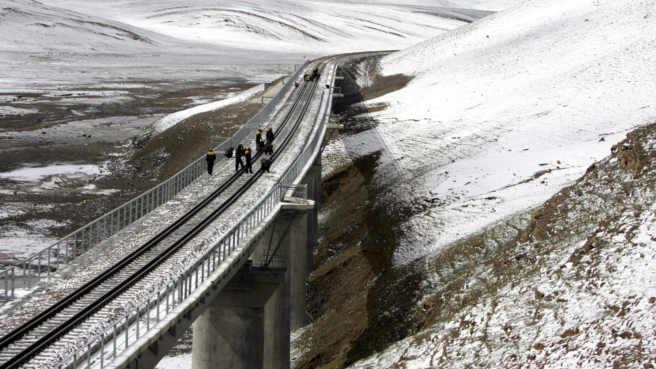March 6, 2014
Qinghai-Tibet Railway, world's highest railway, will reach the residence of Panchen Lama at Xigaze in Tibet

March 6, 2014
Qinghai-Tibet Railway, world's highest railway, will reach the residence of Panchen Lama at Xigaze in Tibet

Beijing: China has extended its rail network in Tibet up to Xigaze, close to the Indian border in Sikkim, a step that would provide its military a strategic capability to easily move troops and weapons in the remote Himalayan region.
The Qinghai-Tibet Railway, the world's highest railway, will reach the residence of the Panchen Lama at Xigaze in Tibet, state-run Xinhua news agency said, emphasizing on its political significance.
The headquarters of China-backed 11th Panchen Lama Gyaincain Norbu is based at Xigaze, also known as Shigatse, located close to the Sikkim border.
The 24-year-old Lama stays in Beijing as he holds a top position in China Buddhist Association.
The seat of Panchan Lama was regarded the second most revered in Tibet after the Dalai Lama. China gives a high-profile projection to Panchan Lama among the Tibetans.
The young Lama was nominated to national advisory body, the Chinese People's Political Consultative Conference.
The Lhasa-Xigaze Railway which has an overall length of 253 km will be ready by October this year, Xinhua said.
The trains will run at a maximum speed of 120 km per hour, representing a run time of about two hours from the regional capital Lhasa to the region's second city.
All subgrade earthworks, bridges, culverts, tunnels and over 93 per cent of the track have been completed.
Currently it takes five hours by road to reach Shigatse from Lhasa.
Both cities are sacred for Tibetan Buddhists with important religious centers such as the Potala Palace, Tashihunpo Monastery and Jokhang Monastery.
"Besides saving time, the railway will be much more safe. The current road is frequently troubled by seasonal natural disasters," said a construction foreman in the railway.
Local residents and tourists will have a smooth trip by rail, unimpeded by landslides in summer and ice in the winter, the worker told Xinhua.
The plateau railway is a particularly problematic construction with difficulties including an oxygen-poor environment, a delicate ecosystem, wildlife migrations and many complex environmental issues.
The 1,956 km long Qinghai-Tibet Railway began service in July 2006 and has positively impacted on Tibet's tourism, hospitality and manufacturing sectors.
China has built extensive network of transport infrastructure in Tibet raising concern in India as it provided strategic advantage to Beijing to move its troops to the borders fast.
Besides well laid highways and rail networks, China built five airports in the Himalayan region so far. The development prompted India to initiate road development along the over 4000 km disputed border area.
Courtesy: PTI
















































































































